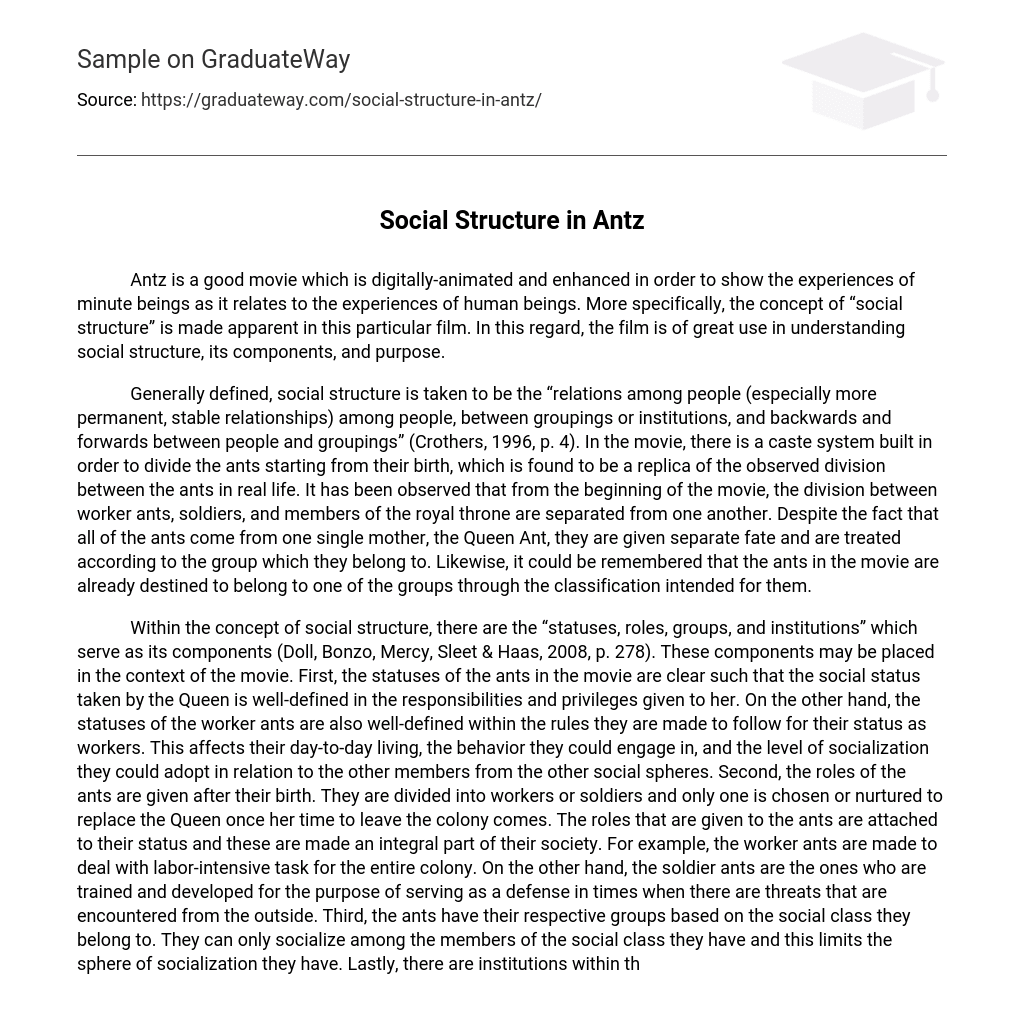Antz is a good movie which is digitally-animated and enhanced in order to show the experiences of minute beings as it relates to the experiences of human beings. More specifically, the concept of “social structure” is made apparent in this particular film. In this regard, the film is of great use in understanding social structure, its components, and purpose.
Generally defined, social structure is taken to be the “relations among people (especially more permanent, stable relationships) among people, between groupings or institutions, and backwards and forwards between people and groupings” (Crothers, 1996, p. 4). In the movie, there is a caste system built in order to divide the ants starting from their birth, which is found to be a replica of the observed division between the ants in real life. It has been observed that from the beginning of the movie, the division between worker ants, soldiers, and members of the royal throne are separated from one another. Despite the fact that all of the ants come from one single mother, the Queen Ant, they are given separate fate and are treated according to the group which they belong to. Likewise, it could be remembered that the ants in the movie are already destined to belong to one of the groups through the classification intended for them.
Within the concept of social structure, there are the “statuses, roles, groups, and institutions” which serve as its components (Doll, Bonzo, Mercy, Sleet & Haas, 2008, p. 278). These components may be placed in the context of the movie. First, the statuses of the ants in the movie are clear such that the social status taken by the Queen is well-defined in the responsibilities and privileges given to her. On the other hand, the statuses of the worker ants are also well-defined within the rules they are made to follow for their status as workers. This affects their day-to-day living, the behavior they could engage in, and the level of socialization they could adopt in relation to the other members from the other social spheres. Second, the roles of the ants are given after their birth. They are divided into workers or soldiers and only one is chosen or nurtured to replace the Queen once her time to leave the colony comes. The roles that are given to the ants are attached to their status and these are made an integral part of their society. For example, the worker ants are made to deal with labor-intensive task for the entire colony. On the other hand, the soldier ants are the ones who are trained and developed for the purpose of serving as a defense in times when there are threats that are encountered from the outside. Third, the ants have their respective groups based on the social class they belong to. They can only socialize among the members of the social class they have and this limits the sphere of socialization they have. Lastly, there are institutions within the ant colony that further reinforces the movement from one class to another. An example of this institution is the socialization area of the ants where only a few classes are allowed to go there.
The social structures are intended and maintained for particular reasons. In the movie, these are also applicable that is why the ants formulated and adopted a particular structure for their colony. First, it serves the purpose of dividing the labor among the people in the colony. The idea herein is that specialization leads to a better performance of tasks and lets the ants concentrate in their respective work. Second, the presence of a social structure helps in maintaining status quo and the continuous reinforcement of the division of labor. Due to the fact that the social classes are assigned, the institutionalization of this would ensure that the current state of segregating ants into classes is maintained for a long time. It can be observed that when the social structure in the ants have disintegrated, the status quo is also dissolved and the differences between the ants have vanished.
The movie Antz is a good illustration of the concept of social structure. It serves as a means through which the function and components can be further analyzed through the experiences of the ants.
References
Crothers, C. (1996). Social structure. New York, NY: Routledge.
Doll, L., Bonzo, S., Mercy, J., Sleet, D., & Haas, E. (2008). Handbook of injury and violence prevention. New York, NY: Springer.





